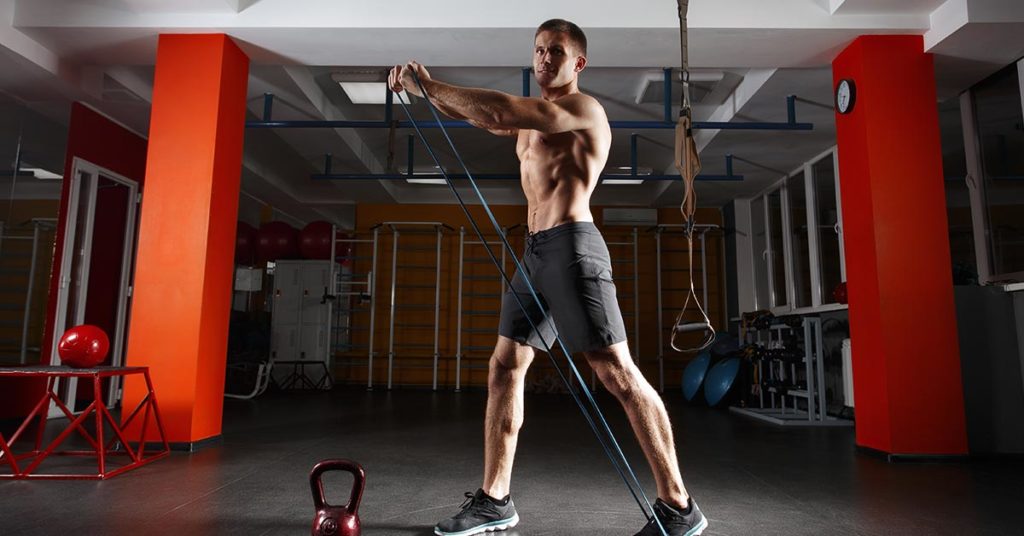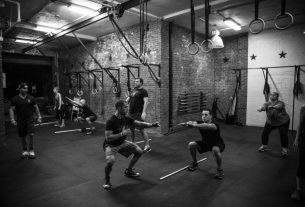Until then, at least we have to train at home and I think a few more weeks myself. The most important home training goal is to maintain muscle mass and if you have been smart you have also opted for dry training for the past 1.5 months. Because then you can add any lost muscle mass in the gym for a few months and you will still be tight in the summer. One of the simplest and strongest ways to sufficiently stimulate your muscle mass is by training with resistance bands . Below you can read a number of important home training tips and you will find a strong home schedule. Looking for quality fitness equipment for your home?
TRAIN WITH RESISTANCE BANDS AND BODYWEIGHT EXERCISES UNTIL MUSCLE FAILURE
Contrary to current scientific knowledge that it is best to stop a set of 1-3 repetitions for muscle failure, you can read in the title of this paragraph that I recommend training to muscle failure with resistance bands and bodyweight exercises. Every set. Don’t think I’m going against science now, because I’m all about stopping 1-3 reps for muscle failure for the best muscle growth results. As you can read in this muscle growth book . However, training to muscle failure with less heavy weights is much more difficult than you think.
EXAMPLE WITH PUSH UPS
An example based on push ups. I’m guessing you can definitely do a push up of 25 if you have to do this now. In fact, do as many push ups as you can now. You will notice that at some point you start to feel pain in your chest. Your brain will say you’re almost there. You’re doing well. Yes, stop now. The moment you stop and pretend you can’t anymore, I’m sure there are 2-3 more reps left. 100%! In 99 out of 100 people, the brain gives up before the muscles.
Basically, if you start a lighter resistance home schedule with the idea that you’re stopping 2 reps for muscle failure, in practice it’s like 5 or more for failure. That means that you do a set in the sense of muscle-stimulating repetitions for nothing. You literally might as well not train. If you want to maintain your muscle mass, provide sufficient stimuli.

EXCEPTION AND THE BEAUTY OF RESISTANCE BANDS
Training to muscle failure applies to resistances with which you can quickly do 15 reps or more. With resistance bands you can make some exercises just as hard as in the gym. You can quickly make a one arm overhead triceps extension so heavy that you can only do 8-10 reps. You can stop these sets for 1-3 reps for muscle failure. In this situation I would still choose 0-1 rep in reserve just to be sure.
MAINTAINING MUSCLE MASS IS MUCH EASIER THAN BUILDING MUSCLE MASS
Don’t think that you will lose a lot of muscle mass if you only do 2-3 workouts at home every week. In the gym you undoubtedly train with heavier weights and you have more options. However, with only 1/3 to 1/9th of the volume you need for muscle building, you can maintain your built-up muscle mass (1). If you dare to train every set to muscle failure 2-3 times a week, you will be fine, provided your nutrition is in order of course. In short, you train at home for a reason. When the gym opens again, I will post a complete blueprint on how to get into top shape as quickly as possible. In fact, I will also tell you the biggest pitfall you will probably fall into… First train at home, for example with the schedule below:

2-DAY HOME SCHEDULE WITH RESISTANCE BANDS
As you have read, 1/3 to 1/9th of your ‘gym volume’ is sufficient to maintain your muscle mass. You can quickly achieve this with a 2 or 3-day full body home schedule. Below you will find an example for 2 days. The days consist of 4 supersets of 2 exercises. You always do 3 sets per exercise of the superset, before moving on to the next superset. The rest interval indicates exactly how long you can wait between exercises. You often see the number of ‘MAX’ in exercises. The intention is that you train until muscle failure, as discussed. If there is a ‘number’, try to set the resistance in such a way that you cannot do more than the number of repetitions given. With a resistance band, this is a matter of slightly more elastic under your foot(s), gripping it narrower or choosing a thicker elastic.



